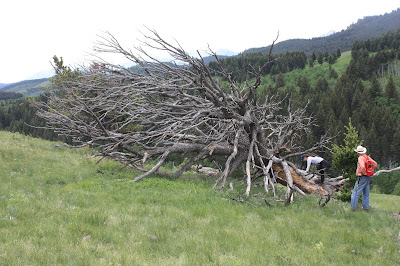Distance: 8 - 10 km, wander your own distance
Elevation gain: 800m
Saturday, June 9, 2018 exactly one year after we had visited a more eastern section of the Whaleback, we were back, this time with the Alberta Wilderness Association and a guide who was very experienced in the area.
We went south on Hwy 22 and west at Maycroft Provincial Park, just before the Oldman River crossing, and then right 11 km on a gravel road to a parking lot.
It was a beautiful day, windy, and with a few clouds - Bob feared thunder and lightning so we hiked in the valley at first as he watched the weather develop. It stayed sunny and warm.
The first stop was a discovery for Herm, he wants to go back and get a sample of this narrow leaf poplar. It is huge, old and an example of the prairie vegetation here.
We walked on and stopped at a former site where elk were collected for distribution in other parks. The only remaining testimony was this invasive plant which we haven't identified.
Bob was very good with plant names and recognized a mystery plant from our hike a year ago - which we saw again - common name: fern leaf biscuit root.
This montane landscape, home to both prairie and mountain flora and fauna is rich, diverse, peaceful and beautiful.
We saw forget-me-nots and then a tall variety which Bob called blue burr. I was surprised since the flowers were so identical. Later as he mentioned the seed (burr) I clued in that we called this plant - stickseed and were too familiar with it. The many different common names for plants causes confusion and is teaching me not to argue about identification of wildflowers.
There were about 15 interesting and knowledgeable people in our group.
Bob led us to a 450 year old Douglas fir, with a curved over top (sign of age) which had withstood many fires thanks to its' thick bark. These firs stand out with their dark green colour and make a fall hike outstanding.
The natural prairie grass, fescue and other varieties is very nutritious for the cattle which graze here but Bob says there are always some which die from eating this larkspur.
We also saw some limber pine, some living, some with a red branch indicating a rust infection and some already dead. The rust had been imported from France years ago and was attacking the pines.
Bob had watched this one die during his 20 years of trekking and defending the natural condition of the Whaleback.
What a lovely day, and interesting hike with enough rest stops to take in this wonderful almost unspoiled landscape.











No comments:
Post a Comment